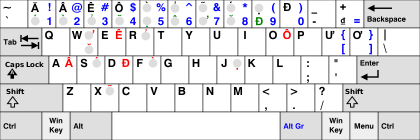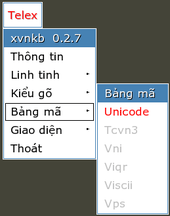Vietnamese language and computers
The Vietnamese language is written with a Latin alphabet that requires several accommodations when computing. Software-based keyboard are the most popular form of writing the Vietnamese language on computer e.g. VNI input method or Telex input method with UniKey (software), an input method editor (IME). Historically, Vietnamese was written in a logographic script, chữ Nôm, which is used for ceremonial and traditional purposes nowadays.
Fonts and character encodings
Vietnamese alphabet
.svg.png)
_in_Calibri.png)
There are as many as 46 character encodings for representing the Vietnamese alphabet.[1] Unicode has become the most popular form for many of the world's writing systems, due to its great compatibility and software support. Diacritics may be encoded either as combining characters or as precomposed characters, which are scattered among the Latin Extended-A, Latin Extended-B, and Latin Extended Additional blocks. The Vietnamese đồng symbol is encoded in the Currency Symbols block. Historically, the Vietnamese language used other characters beyond the modern alphabet. The Middle Vietnamese letter B with flourish (ꞗ) is included in the Latin Extended-D block. The apex is not included in Unicode, but U+1DC4 ◌᷄ COMBINING MACRON-ACUTE may serve as a rough approximation.
Early versions of Unicode assigned the characters U+0340 ◌̀ COMBINING GRAVE TONE MARK and U+0341 ◌́ COMBINING ACUTE TONE MARK for the purpose of placing these marks beside a circumflex, as is common in Vietnamese typography. These two characters have been deprecated; U+0301 ◌́ COMBINING ACUTE ACCENT and U+0300 ◌̀ COMBINING GRAVE ACCENT are now used regardless of any present circumflex.[2]
For systems that lack support for Unicode, dozens of 8-bit Vietnamese code pages have been designed.[1] The most commonly used of them were VISCII, VSCII (TCVN 5712:1993), VNI, VPS and Windows-1258.[3][4] Where ASCII is required, such as when ensuring readability in plain text e-mail, Vietnamese letters are often encoded according to Vietnamese Quoted-Readable (VIQR) or VSCII Mnemonic (VSCII-MNEM),[5] though usage of either variable-width scheme has declined dramatically following the adoption of Unicode on the World Wide Web. For instance, support for all above mentioned 8-bit encodings, with the exception of Windows-1258, was dropped from Mozilla software in 2014.[6]
Many Vietnamese fonts intended for desktop publishing are encoded in VNI or TCVN3 (VSCII).[4] Such fonts are known as "ABC fonts".[7] Popular web browsers lack support for specialty Vietnamese encodings, so any webpage that uses these fonts appears as unintelligible mojibake on systems without them installed.

Vietnamese frequently stacks diacritics, so typeface designers must take care to prevent stacked diacritics from colliding with adjacent letters or lines. When a tone mark is used together with another diacritic, offsetting the tone mark to the right preserves consistency and avoids slowing down saccades.[8] In advertising signage and in cursive handwriting, diacritics often take forms unfamiliar to other Latin alphabets. For example, the lowercase letter I retains its tittle in ì, ỉ, ĩ, and í.[9] These nuances are rarely accounted for in computing environments.
Approaches
Vietnamese writing requires 134 additional letters (between both cases) besides the 52 already present in ASCII.[10] This exceeds the 128 additional characters available in a conventional extended ASCII encoding. Although this can be solved by using a variable-width encoding (as is done by UTF-8), a number of approaches have been used by other encodings to support Vietnamese without doing so:
- Replace at least six ASCII characters, selected either for being uncommon in Vietnamese, and/or for being non-invariant in ISO 646 or DEC NRCS[10] (as in VNI for DOS).
- Drop the uppercase letters which are least frequently used,[10] or all uppercase letters with tone marks (as in VSCII-3 (TCVN3)). These letters may still be supplied by means of all-capital fonts.[11]
- Drop forms of the letter Y with tone marks, necessitating use of the letter I in those circumstances. This approach was rejected by the designers of VISCII on the basis that a character encoding should not attempt to settle a spelling reform issue.[10]
- Replace at least six C0 control characters[10] (as in VISCII, VSCII-1 (TCVN1) and VPS).
- Use combining characters, allowing one vowel with accents to be fully represented using a sequence of characters (as in VNI, VSCII-2 (TCVN2), Windows-1258 and ANSEL).
Chữ Nôm
Unicode includes over 10,000 nôm characters as part of Unicode's repertoire of CJK Unified Ideographs. Of these characters, 10,082 can be found in the CJK Unified Ideographs Extension B block, while the rest are distributed between the CJK Unified Ideographs, CJK Unified Ideographs Extension A, and CJK Unified Ideographs Extension C blocks. A further 1,028 characters, including over 400 characters specific to the Tày language, are encoded in the CJK Unified Ideographs Extension E block. The characters are taken from the Vietnamese standards TCVN 5773:1993 and TCVN 6909:2001 [error for TCVN 6056:1995?], as well as from research by the Han-Nom Research Institute and other groups.[13] All the characters in TCVN 5773:1993 and about 95% of the characters in TCVN 6909:2001 [error for TCVN 6056:1995?] have corresponding codepoints in Unicode 5.1, though TCVN 5773:1993 itself mapped most of its characters to the Private Use Area of Unicode.[14] Unicode 13.0 added two diacritical characters to the Ideographic Symbols and Punctuation block that were commonly used to indicate borrowed characters in chữ Nôm.[15][16]
The two most comprehensive nôm fonts are the Vietnamese Nôm Preservation Foundation's Nôm Na Tống Light[17] and the community-developed HAN NOM A/HAN NOM B,[18] both of which place a large number of unstandardized characters in the Private Use Areas.
The Unicode Consortium's Unihan database includes Vietnamese readings of some characters but does not distinguish between Sino-Vietnamese and nôm readings.
Like other CJKV writing systems, chữ Nôm is traditionally written vertically, from top to bottom and right to left.
Both chữ Hán and chữ Nôm may also be annotated using ruby characters, which is the same as chữ quốc ngữ for Vietnamese.[19]
Text input
A purely physical Vietnamese keyboard would be impractical, due to the sheer number of letter-diacritic-diacritic combinations in the alphabet. Instead, Vietnamese input relies on software-based keyboard layouts, virtual keyboards, or input methods (also known as IMEs).
Keyboard layouts


Vietnamese keyboard layouts rely on dead keys to compose letters with diacritics. Most desktop operating systems include a Vietnamese keyboard layout similar to TCVN 6064:1995, a Vietnamese national standard. Previously, typewriters used an AZERTY-based Vietnamese layout.[20]
Input methods

The three most common Vietnamese input methods are Telex, VNI, and VIQR. Telex indicates diacritics using letters that are unlikely to appear at the end of a word, while VNI repurposes the number keys or function keys and VIQR repurposes various punctuation marks. The Telex and VIQR conventions originated in an earlier era of telex machines and typewriters, respectively.
Support for these input methods is provided by input method editors (IMEs), which are known in Vietnamese as bộ gõ, literally "pecker". IMEs may be provided by the operating system, installed as a third-party application, installed as a browser extension, or provided by an individual website in the form of a script. Common third-party applications include GoTiengViet, UniKey, VietKey, VPSKeys, WinVNKey, and xvnkb. On Unix-like operating systems, the IBus and SCIM frameworks both support Vietnamese. IMEs scripts such as AVIM, Mudim, and VietTyping can be found on most Vietnamese message boards, the Vietnamese Wikipedia, and other text-intensive websites. The Vietnamese Web browser Cốc Cốc comes with an input method built-in.
Input methods allow words to be composed in a more flexible order than keyboard layouts allow. For example, to enter the word "viết" using the TCVN 6064:1995 keyboard layout, one must type VI38T, in that order. By contrast, most IMEs permit the user to insert diacritics at the end of the word: VIEETS in Telex, VIET61 in VNI, or VIET^' in VIQR. Some IMEs even allow diacritics to be entered before their base letters. Depending on an IME's implementation, it may also be possible to edit an existing word's diacritics without retyping the word.
Borrowing a feature common among Chinese input methods, some Vietnamese IMEs allow one to skip diacritics altogether. Instead, after typing the base letters, the user selects the accented word from a candidate list. In order to provide this autocomplete list, the IME may need to communicate with a Web service. Some IMEs also use candidate lists to allow the user to convert text from the Vietnamese alphabet to chữ Nôm, because there is no one-to-one correspondence between alphabetic words and nôm characters.
Other considerations
Typical Vietnamese text contains a high proportion of compound words. Compound words are never hyphenated in contemporary usage, so spell checkers are limited to checking individual syllables unless a statistical language model is consulted.
Vietnamese has rigid spelling rules and few exceptions, so text-to-speech engines may avoid dictionary lookups except when encountering a foreign loan word. TTS engines must account for tones, which are essential to the meaning of any Vietnamese word.
See also
References
- Ngô Đình Học; Trần Tư Bình (July 21, 2014). "Express Manual for WinVNKey". WinVNKey. Retrieved October 5, 2014.
- "Combining Diacritical Marks". Unicode 7.0 Character Code Charts. Unicode Consortium. June 16, 2014. Retrieved October 5, 2014.
- Ngo, Hoc Dinh; Tran, TuBinh. "5. Why Having Vietnamese Charset (Character Set – Encoding) Conversion?". Some special functions of WinVNKey.
- "Chọn Font chữ, bảng mã để gõ tiếng Việt". Bộ gõ tiếng Việt.Com (in Vietnamese). MangVN. 2009. Archived from the original on November 20, 2010.
- Lunde, Ken (2009). CJKV Information Processing (2nd ed.). O'Reilly Media. pp. 47–49. ISBN 978-0-596-51447-1 – via Google Books.
- Sivonen, Henri (2014-09-26). "Character encoding changes in m-c require c-c action". mozilla.dev.apps.thunderbird.
- Hoàng Tô; Nguyễn Quan Sơn; Nguyễn Sơn Tùng; Phan Quang Minh; Phạm Thúc Trương Lương; Nguyễn Quang Hiệp; Bùi Văn Kiên; Nguyễn Ích Vinh (20 July 2014). Sử ký Tinh Vân: 20 năm sẻ chia và sáng tạo [History of Tinhvan: 20 years of sharing and creating] (in Vietnamese). 1. Tinhvan Group. p. 37 – via Google Books.
- Trương, Donny. "Design Challenges". Vietnamese Typography. Retrieved April 10, 2018.
- See, for example: "Viết Thư". Vietnamese reading selections (in Vietnamese) (2 ed.). Army Language School. 1956. pp. 98–100.
- "2. Review Of Current Conventions". Vietnamese Character Encoding Standardization Report - VISCII And VIQR 1.1 Character Encoding Specifications (Technical report). Viet-Std Group. 1992. p. 10.
- "Unicode & Vietnamese Legacy Character Encodings". Vietnamese Unicode FAQs.
TCVN3 is not double-byte, but due to the nature of its encoding, capital letters (vowels) are mapped to a separate, capital font that is similar to the normal, lowercase one.
- Trần Văn Kiệm (2004). "phở". Giúp đọc Nôm và Hán Việt (in Vietnamese) (4th ed.).
- Nguyễn Quang Hồng. "Giới thiệu Kho chữ Hán Nôm mã hoá" [Hán Nôm Coded Character Repertoire Introduction] (in Vietnamese). Vietnamese Nôm Preservation Foundation.
- Lunde 2009, pp. 152–153.
- Collins, Lee; Ngô Thanh Nhàn (6 November 2017). "Proposal to Encode Two Vietnamese Alternate Reading Marks" (PDF).
- "Proposed New Characters: The Pipeline". Unicode Consortium. 8 May 2019. Retrieved 26 May 2019.
- "Nôm Font". Vietnamese Nôm Preservation Foundation. Retrieved October 5, 2014.
- Đỗ Quốc Bảo; Tô Minh Tâm; Thiền Viện Viên Chiếu (December 8, 2005). "UNICODE Han Nom Font Set". Retrieved October 5, 2014.
- Lunde 2009, p. 529.
- Duncan, John William (2005-12-22), VietNamese Typewriter, retrieved 2020-07-11
Further reading
- Lunde, Ken (2009). CJKV Information Processing. Sebastopol, California: O'Reilly Media. ISBN 978-0-596-51447-1 – via Google Books.CS1 maint: ref=harv (link)
External links
- Computing in Vietnamese: Progress & Challenges – 2005 International Macintosh Users Group presentation
- Vietnamese Conversions – online tool for recovering Vietnamese mojibake
